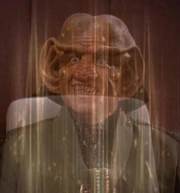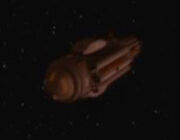Renegade54 (talk | contribs) m (+ category) |
Renegade54 (talk | contribs) m (copyedit) |
||
| (21 intermediate revisions by 13 users not shown) | |||
| Line 1: | Line 1: | ||
| + | [[File:Subspace transporter.jpg|thumb|Bok uses a Ferengi subspace transporter]] |
||
| − | + | The '''subspace transporter''' was a type of [[transporter]] [[technology]] that used [[subspace]] instead of normal [[space]] to transport matter. ({{TNG|Bloodlines}}) |
|
| + | ==Technology== |
||
| − | Unlike a normal [[transporter]], which sends its signal through normal [[space]] and thus limited to a much shorter range, this transporter uses subspace. Compared to a normal [[Federation]] transporter, which had a range of about 40,000 [[kilometer]]s, it has a range of several [[light year]]s. A [[probe]] was once transported from a distance of approximately 300 billion kilometers this way. For comparison, a {{ShipClass|Galaxy}} [[starship]] would take twenty minutes at [[warp]] 9 to bridge this distance. A transport in progress would not be detected by [[sensor]]s because of the use of subspace. |
||
| + | In the [[24th century]], a normal [[Federation]] transporter system, that sent its signal through normal space, was limited to a range of about 40,000 [[kilometer]]s. The range of a subspace transporter was several [[light year]]s. The matter that was transported needed to be in a state of [[quantum flux]], which was highly unstable. It was possible to attempt to stop a subspace transporter beam-out with another transporter system tied into [[subspace field coil]]s. The other transporter had to maintain pattern lock on the matter that was about to be beamed away with the the subspace transporter. [[Deflector shield]]s could not stop a subspace transport. |
||
| + | Under normal circumstances, a subspace transport could not be detected with [[sensor]]s. However, if the signature of a subspace transporter was known, it was possible to detect when a particular subspace carrier wave was approaching and focusing. This made it possible to determine where the source and target [[coordinates]] of the transporter beam were. A person who had used a subspace transporter would leave this distinct subspace signature on anything they came in contact with. This contact needed to be more than brief though. Depending on the type of transporter, the subspace signature might decay faster than normal. |
||
| − | Although transporting through subspace increased the effective transporter range and made it possible to beam through [[deflector shield]]s, the [[technology]] behind it was unreliable and [[energy]] intensive. Because it uses subspace to transport [[matter]], this matter needed to be in a state of quantum flux. Not only is this highly unstable, it also is the reason sensors cannot detect a transport in progress or that shields can prevent transporting. |
||
| + | Standard Federation transporters could be modified to transport via subspace by aligning the field coils tied into the system and synchronizing the [[phase damper]]s, after which the transport pattern was modulated. The transport sequence itself was longer than normal because the pattern needed to be shunted through the subspace field coils. ({{TNG|Bloodlines}}) |
||
| − | If the signature of a subspace transporter is known, one can detect it when a particular subspace carrier wave is approaching. This makes it also possible to determine where the end coordinates of the [[transporter beam]] will be. |
||
| + | ==Uses== |
||
| − | Someone who used a subspace transporter would leave a distinct subspace signature on anything he or she came in contact with, although this contact needed to be more than brief. To prevent a beam-out with such a transporter a pattern lock needed to be prevented. Because the transporter operates via subspace the [[subspace field coil]]s needed to be tied into the transporter system. Depending on the type of transporter the subspace signature might decay faster than normal, making it difficult but not impossible to determine the origin of the transporter beam. |
||
| + | [[File:Ferengi probe.jpg|thumb|A [[Ferengi probe]] subspace transported by Bok]] |
||
| + | Some time before [[2370]], the Federation had researched subspace transporter technology, but deemed such devices impractical. Development was abandoned because of the unreliability and [[energy]] requirements of the technology. The only people known to have utilized a subspace transporter were [[DaiMon]] [[Bok]] and the crew of {{USS|Enterprise|NCC-1701-D|-D}}. |
||
| − | + | In 2370, Bok subspace transported himself two times, two [[Ferengi probe]]s and [[Jason Vigo]] instantaneously between a distance of approximately 300 billion kilometers (0.03 [[light year]]s) from his ship. For comparison, it would have taken twenty minutes at [[Warp factor|warp 9]] for a [[starship]] to bridge the distance. [[Geordi La Forge]] and [[Data]] modified the transporter of the ''Enterprise''-D to subspace transport [[Jean-Luc Picard]] to Bok's ship. ({{TNG|Bloodlines}}) |
|
| + | ==Appendices== |
||
| − | The Federation researched this technology but abandoned it because of its unreliability and energy requirements. The only one who once used a subspace transporter was DaiMon Bok when he tried to get even with [[Captain]] Picard for killing his son. ({{TNG|Bloodlines}}) |
||
| ⚫ | |||
| + | * [[Spatial trajector]] |
||
| ⚫ | |||
| + | * [[Transwarp beaming]] |
||
| + | ===Background information=== |
||
| − | + | In the earlier [[TNG Season 6|season 6]] episode {{TNG|Realm of Fear}}, [[Reginald Barclay]] cited his [[Transporter Theory]] class in which Dr. Olafson talked about "''the body being converted into billions of kiloquads of data, zipping through subspace.''" This would seem to suggest that all transporters operate by transporting matter through subspace and would seem to conflict with the description of the difference between a normal and a subspace transporter from the [[TNG Season 7|season 7]] episode "Bloodlines". |
|
| + | [[de:Subraumtransporter]] |
||
| ⚫ | |||
| + | [[fr:Téléporteur subspatial]] |
||
| ⚫ | |||
[[Category:Subspace]] |
[[Category:Subspace]] |
||
[[Category:Transporter technology]] |
[[Category:Transporter technology]] |
||
Revision as of 21:32, 17 November 2014

Bok uses a Ferengi subspace transporter
The subspace transporter was a type of transporter technology that used subspace instead of normal space to transport matter. (TNG: "Bloodlines")
Technology
In the 24th century, a normal Federation transporter system, that sent its signal through normal space, was limited to a range of about 40,000 kilometers. The range of a subspace transporter was several light years. The matter that was transported needed to be in a state of quantum flux, which was highly unstable. It was possible to attempt to stop a subspace transporter beam-out with another transporter system tied into subspace field coils. The other transporter had to maintain pattern lock on the matter that was about to be beamed away with the the subspace transporter. Deflector shields could not stop a subspace transport.
Under normal circumstances, a subspace transport could not be detected with sensors. However, if the signature of a subspace transporter was known, it was possible to detect when a particular subspace carrier wave was approaching and focusing. This made it possible to determine where the source and target coordinates of the transporter beam were. A person who had used a subspace transporter would leave this distinct subspace signature on anything they came in contact with. This contact needed to be more than brief though. Depending on the type of transporter, the subspace signature might decay faster than normal.
Standard Federation transporters could be modified to transport via subspace by aligning the field coils tied into the system and synchronizing the phase dampers, after which the transport pattern was modulated. The transport sequence itself was longer than normal because the pattern needed to be shunted through the subspace field coils. (TNG: "Bloodlines")
Uses

A Ferengi probe subspace transported by Bok
Some time before 2370, the Federation had researched subspace transporter technology, but deemed such devices impractical. Development was abandoned because of the unreliability and energy requirements of the technology. The only people known to have utilized a subspace transporter were DaiMon Bok and the crew of USS Enterprise-D.
In 2370, Bok subspace transported himself two times, two Ferengi probes and Jason Vigo instantaneously between a distance of approximately 300 billion kilometers (0.03 light years) from his ship. For comparison, it would have taken twenty minutes at warp 9 for a starship to bridge the distance. Geordi La Forge and Data modified the transporter of the Enterprise-D to subspace transport Jean-Luc Picard to Bok's ship. (TNG: "Bloodlines")
Appendices
See also
Background information
In the earlier season 6 episode TNG: "Realm of Fear", Reginald Barclay cited his Transporter Theory class in which Dr. Olafson talked about "the body being converted into billions of kiloquads of data, zipping through subspace." This would seem to suggest that all transporters operate by transporting matter through subspace and would seem to conflict with the description of the difference between a normal and a subspace transporter from the season 7 episode "Bloodlines".
